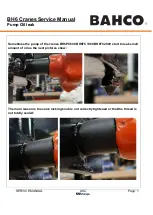
3-20
2.
Feed face pack straps into head support assembly, as shown
at right.
3.
Press face pack down to secure patient’s head. Straps will
click as they are tightened. Face pack should be tightened
only so that pack rests lightly on patient’s forehead and
cheeks with no compression of the foam.
Tighten straps as evenly as possible, from left to right
and head to foot.
Tightness of face pack may be adjusted by pressing and holding the release plate again.
Avoid applying pressure on or near patient’s eyes, nose or mouth. Prolonged, increased
intraoccular pressure may potentially cause eye injury, including blindness.
4.
Assess face pack position:
• Opening on pack should frame patient’s eyebrows
to the bottom of patient’s nostrils, as shown at
right.
• U-shaped openings on face pack should frame
patient’s mouth, as shown at right.
• Pack should lightly touch patient’s forehead, cheeks
and chin with no compression of the foam.
5.
Adjust face pack cheek plate, if necessary:
• Remove face pack.
• Turn adjustment screws to loosen face pack cheek plate.
• Cheek plate may be raised, lowered, or angled, as needed, to accommodate patient’s face shape.
• Tighten adjustment screws.
• Reinstall face pack and check pack position again.
6.
Assess position of cheek packs on patient’s cheeks and chin. As described above, face pack should rest
lightly on patient’s forehead, cheeks and chin with no compression of the foam.
Cheek Plate
Summary of Contents for RotoProne
Page 2: ......
Page 6: ......
Page 8: ......
Page 39: ...2 27 ...
Page 40: ...2 28 ...
Page 76: ...4 8 ...
Page 82: ...6 2 ...
















































